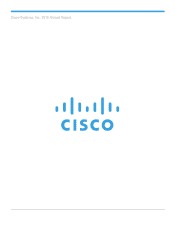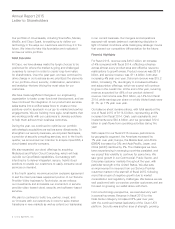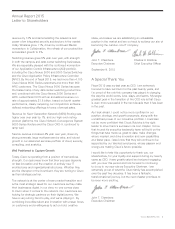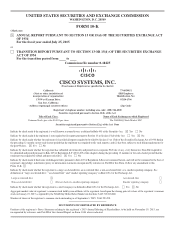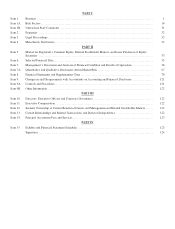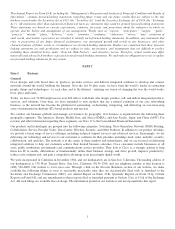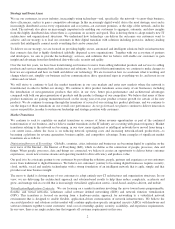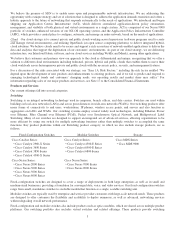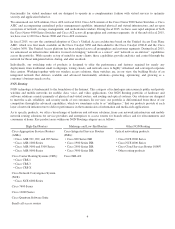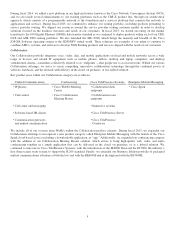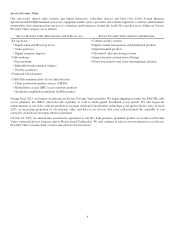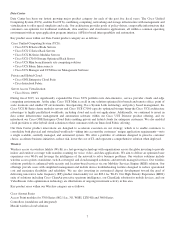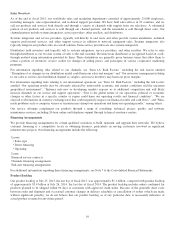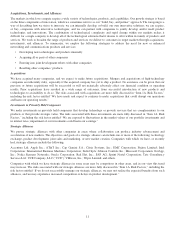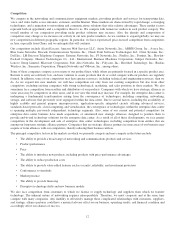Cisco 2015 Annual Report Download - page 10
Download and view the complete annual report
Please find page 10 of the 2015 Cisco annual report below. You can navigate through the pages in the report by either clicking on the pages listed below, or by using the keyword search tool below to find specific information within the annual report.
Strategy and Focus Areas
We see our customers, in every industry, increasingly using technology—and, specifically, the network—to grow their business,
drive efficiencies, and try to gain a competitive advantage. In this increasingly digital world, data is the most strategic asset and is
increasingly distributed across every organization and ecosystem—on customer premises, at the edge of the network, and in the
cloud. The network also plays an increasingly important role enabling our customers to aggregate, automate, and draw insights
from this highly distributed data where there is a premium on security and speed. This is driving them to adopt entirely new IT
architectures and organizational structures. We understand how technology can deliver the outcomes our customers want to
achieve, and our strategy is to lead our customers in their digital transition with solutions including pervasive, industry-leading
security that intelligently connect nearly everything that can be connected.
To deliver on our strategy, we are focused on providing highly secure, automated and intelligent solutions built on infrastructure
that connects data that is highly distributed (globally dispersed across organizations). Together with our ecosystem of partners
and developers, we aim to provide the technology, services, and solutions that we believe will enable our customers to gain
insight and advantage from this distributed data with scale, security and agility.
Over the last few years, we have been transforming our business to move from selling individual products and services to selling
products and services integrated into architectures and solutions. As a part of this transformation, we continue to make changes to
how we are organized and how we build and deliver our technology. We are focused on how we accelerate what is working and
change what is not, simplify our business and our communication, drive operational rigor in everything we do, and invest in our
culture and our talent.
We will strive to continue to lead the market transitions in our core markets and enter new markets where the network is
foundational, in order to further our strategy. We continue to drive product transitions across many of our businesses, including
the introduction of next-generation products that offer, in our view, better price-performance and architectural advantages
compared with both our prior generation of products and the product offerings of our competitors. We believe that many of these
product transitions are gaining momentum based on the strong year-over-year product revenue growth for certain of the new
products. We do continue to manage through the transitions of several of our existing key product platforms, and we continue to
see the impact of those transitions on our overall core performance. As we go forward, we plan to continue to deliver innovation
across our portfolio, in order to sustain our leadership and strategic position with customers.
Market Transitions
We continue to seek to capitalize on market transitions as sources of future revenue opportunities as part of the continued
transformation of our business, and we believe market transitions in the IT industry are occurring with greater frequency. Market
transitions relating to the network are becoming, in our view, more significant as intelligent networks have moved from being a
cost center issue—where the focus is on reducing network operating costs and increasing network-related productivity—to
becoming a platform for revenue generation, business agility, and competitive advantage. Some examples of significant market
transitions are as follows:
Digitization/Internet of Everything Globally, countries, cities, industries and businesses are becoming digital to capitalize on the
next wave of the Internet - the Internet of Everything (IoE), which we define as the connection of people, processes, data and
things. When people, processes, data and things are connected, we believe it creates an opportunity to deliver better customer
experiences, create new revenue streams and operating models to drive efficiency and produce value.
Our goal is to be a strategic partner to our customers by providing the solutions, people, partners and experience as our customers
move from traditional to digital businesses. We believe our customers’ journey to becoming digital businesses requires security,
cloud, mobile, social and analytic technologies with a strong foundation of an intelligent network that is agile, simple and that
provides real time business insight.
The move to digital is driving many of our customers to adopt entirely new IT architectures and organization structures. In our
view, we are delivering the architectural approach and solution-based results to help them reduce complexity, accelerate and
grow, and manage risk in a world that is increasingly virtualized, application centric, cloud-based, analytics-driven, and mobile.
Virtualization/Application Centricity We are focusing on a market transition involving the move toward more programmable,
flexible, and virtual networks, sometimes called software defined networking (SDN) and network function virtualization
(NFV). This transition is focused on moving from a hardware-centric approach for networking to a virtualized network
environment that is designed to enable flexible, application-driven customization of network infrastructures. We believe the
successful products and solutions in this market will combine application-specific integrated circuits (ASICs) with hardware and
software elements together to meet customers’ total cost of ownership, quality, security, scalability, and experience requirements.
In our view, there is no single architecture that supports all customer requirements in this area.
2

